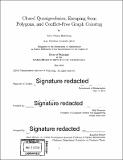Closed quasigeodesics, escaping from polygons, and conflict-free graph coloring
Author(s)
Hesterberg, Adam Classen
DownloadFull printable version (7.530Mb)
Other Contributors
Massachusetts Institute of Technology. Department of Mathematics.
Advisor
Erik Demaine.
Terms of use
Metadata
Show full item recordAbstract
Closed quasigeodesics. A closed quasigeodesic on the surface of a polyhedron is a loop which can everywhere locally be unfolded to a straight line: thus, it's straight on faces, uniquely determined on edges, and has as much flexibility at a vertex as that vertex's curvature. On any polyhedron, at least three closed quasigeodesics are known to exist, by a nonconstructive topological proof. We present an algorithm to find one on any convex polyhedron in time O(n2[epsilon]-2- 2Ll-1 ), where [epsilon] e is the minimum curvature of a vertex, l is the length of the longest side, and t is the smallest distance within a face between a vertex and an edge not containing it. Escaping from polygons. You move continuously at speed 1 in the interior of a polygon P, trying to reach the boundary. A zombie moves continuously at speed r outside P, trying to be at the boundary when you reach it. For what r can you escape and for what r can the zombie catch you? We give exact results for some P. For general P, we give a simple approximation to within a factor of roughly 9.2504. We also give a pseudopolynomial-time approximation scheme. Finally, we prove NP-hardness and hardness of approximation results for related problems with multiple zombies and/or humans. Conflict-free graph coloring. A conflict-free k-coloring of a graph assigns one of k different colors to some of the vertices such that, for every vertex v, there is a color that is assigned to exactly one vertex among v and v's neighbors. We study the natural problem of the conflict-free chromatic number XCF(G) (the smallest k for which conflict-free k-colorings exist), with a focus on planar graphs.
Description
Thesis: Ph. D., Massachusetts Institute of Technology, Department of Mathematics, 2018. Cataloged from PDF version of thesis. Includes bibliographical references (pages 56-58).
Date issued
2018Department
Massachusetts Institute of Technology. Department of MathematicsPublisher
Massachusetts Institute of Technology
Keywords
Mathematics.